| Author | Message | ||
Jeepinbueller |
Well, a few expressed some interest for a write-up for an HID kit being installed on their Buell ... I did it for my 2003 XB9R Firebolt: When it comes to lighting and vehicles -- whether they be of the four- or two-wheeled variety -- I don't mess around. I've installed numerous plug and play HID kits over the years, getting better every time. After being asked about my Buell at gas stations, stop lights, anywhere really, it eventually leads to how nice the headlights look. I installed DDM's "Raptor" 35W, 6000K HID kit (DDMTuning.com). Because of Erik's awesome decision to have projector headlamps from the factory on the R models, you can enjoy perfect HID lighting with no glare at all ... the difference is amazing. I chose to just get the cheapest kit DDM offered and I wasn't upset at all with the quality ... compared to other kits I've had over the years (VVME and eBay), the DDMs are easily the best quality in their components (everything is potted so it's weatherproof) and connectors. You can get a regular automotive low beam HID kit and it'll work fine ... you'll just you one bulb/ballast for the low beam, and the other for the high beam. You really shouldn't use the stock wiring to POWER the ballasts ... that task should be left up to a pair of fused relays which you can pick up at any automotive store or Radio Shack (30 or 40 amp relays are fine). Your stock wiring (the power and ground wires that connected to you stock H3 bulbs) are used to simply switch the relays on and off with the relays drawing power directly from the battery (fused, of course). Some things you will need if you want to do a clean install: - Two rolls of 10 or 12 gauge wire, each a different color (to keep power and ground easily distinguishable) - Two 30 or 40 amp relays (one for high beam ballast, the other for the low beam ballast) - 30 amp fuse - In-line fuse holder - An assortment of crimp-on wire terminals (whether it be spade, bullet, etc. is your choice for wire-to-wire connections ... you'll need ring terminals for battery and ground connections) - If you're going to be soldering, you'll obviously need a soldering gun and thin solder - Assorted sizes of shrink wrap and a heat source like a blow dryer - Dielectric grease (this is optional ... I used it on all connections to further weatherproof it) - 3M doubled-sided adhesive foam - Assorted zip ties - Crimping/electrician's pliers -=-=-=-=-=-=-=-=-=-=-=-=-=-=-=-=-=-=-=-=-=-= Onto how I did things: To preface, on all wire connections that I knew would be permanent, like splicing in the in-line fuse holder near the battery, I soldered then heat shrunk. For connections that I knew might need to be removed, like the bulb, ballast, and relay connections, I crimped the connection on, heat shrunk, and added dielectric grease on the actual mating surfaces of the connection. This will keep it as weatherproof as possible. I used this schematic I drew to keep things organized: 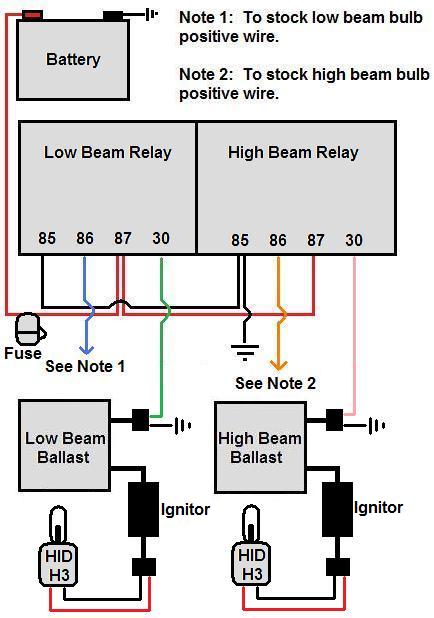 You need to remove your seat, air box cover, upper and lower air box/filter, front turn signals, mirrors, fairing, disconnect headlight wires, and remove projectors. 1.) Eyeball the length of wire you'll need for the in-line fuse holder and splice it in. I made it so the battery strap held the fuse in place. Leave the fuse out so you can add a ring terminal to the wire and connect to the battery without worrying about being shocked. 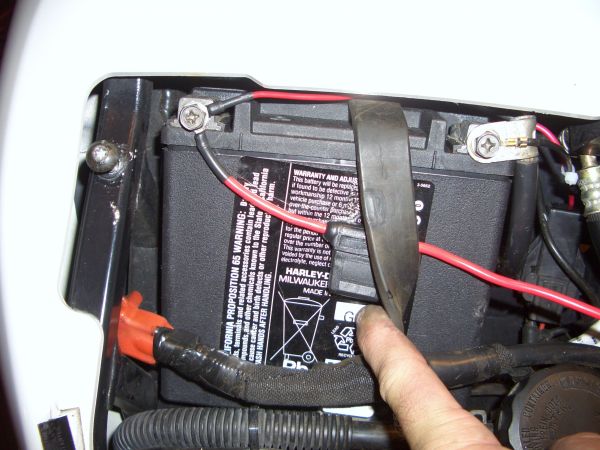 2.) Route the power wire to the front, following the stock wiring harness to the left side of the triple tree. I put the power wire to on the outside of the stock harness to keep as much engine heat away from the wire as possible. 3.) Use the adhesive foam to attach the two relays together side by side. 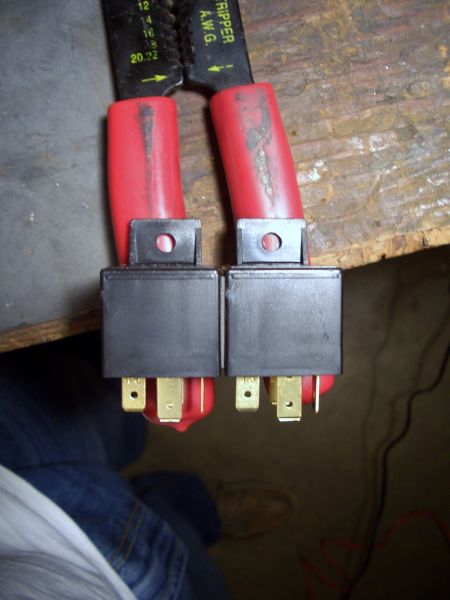 I'll take this time to explain how the actual HIDs and all the components work together. You need a couple things to make a system like this work: a power source, a signal source, and the output. The power source is the relays/ballasts and, ultimately, the battery. The signal source, which tells the ballasts when to start up and ignite the bulbs, goes through the relays and are "signaled" by the stock headlight bulbs. If you don't know this, a relay is just a heavy duty switch that takes the load off your stock switches and wiring. So when you turn the ignition on or flick on the high beams, the wires that WOULD have turned on the stock bulbs are now actually signaling the relay to let the power flow to the correct ballast, which in turn ignites the correct HID bulb. Kind of confusing, but that's how it works. The relays you use for this application have four pins: 85, 86, 87, and 30. These "pins" are male spade connectors, so to connect your wires to the relays you just need to crimp on female spade terminals. Pin 85 is the ground, 86 is the signal wire (which is just the stock headlight positive wires that are extended to reach), 87 is the input power from the battery, and 30 is the output wire to each ballast positive. Pins 85 and 87 are "daisy chained" to the other relay b/c their functions (ground and power) are the same on both relays (so pin 85 on on relay is connected to pin 85 on the other, and same for pins 87). This keeps you from running two power wires from the battery. 4.) Hook up the relays as shown ... this part you're on your own. Just look at the pictures and the diagram ... it'll come together. I mounted the relays using the 3M foam on top of the stock indicator relay. You can see in this picture the relays mounted and the power (red) and ground (blue) connected and jumped. 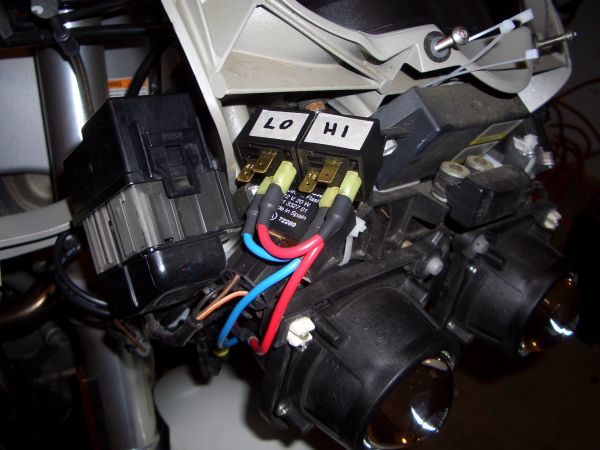 5.) Now you need to tell the relays when to switch on. Hopefully you've labeled your relays so you know which one controls which ballast. It doesn't really matter which does which, as long as your signal and output wires are for the same bulb ... otherwise you'll switch on your high beam and your low beam will ignite, and vice versa. Take the power wire that used to go to the low beam OEM bulb and extend it to connect to the 86 pin on your low beam relay. Do the same for your high beam signal wire to your high beam relay. 6.) Now just ground your relays (should only be one wire if you jumped them together) to the stock ground location on the front of the lower triple tree bracket. You'll need a ring terminal for this. 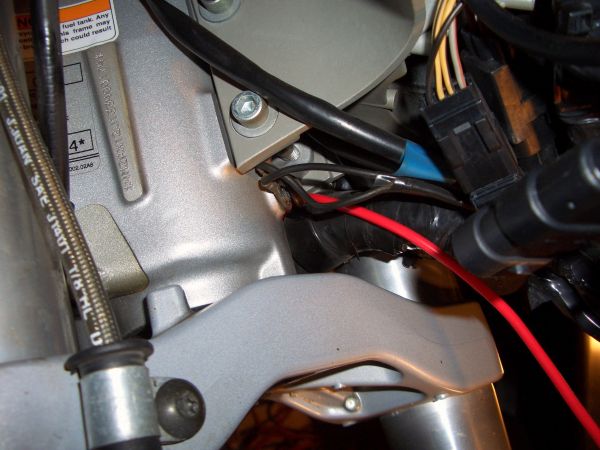 7.) If you haven't already put your new HID H3 bulbs in the projectors, do that now being careful NOT to touch the glass portion of the bulb ... the oils on your skin will weaken the glass once heated and could cause a failure. The bulbs will only do in one way denoted by a little tab/detent. You may have to widen the whole in the dust cover slightly to fit the bulb wire connectors through, but I could fit both of my wire connectors through with no trouble. 8.) You may decide to mount your ballasts elsewhere, but mine are just zip tied to the top of the projector housing once reinstalled. Seems to work fine as long as you secure them in both directions (left/right, forward/backward). 9.) Since this is a kit for cages, the power connector for the ballasts was too long so I shortened them and connected them to the relays. You can reuse the stock ground wire for the OEM bulbs to connect to the ballast ground. Since they're already connected to the lower triple tree bracket ground, it just seemed logical to reuse them. 10.) I used the 3M foam to secure the ignitor boxes on the inside of the fairing frame. Here you can see the rest of the wiring complete, the ballast on top of the rear projector, the ignitor mounted, and basically everything else. 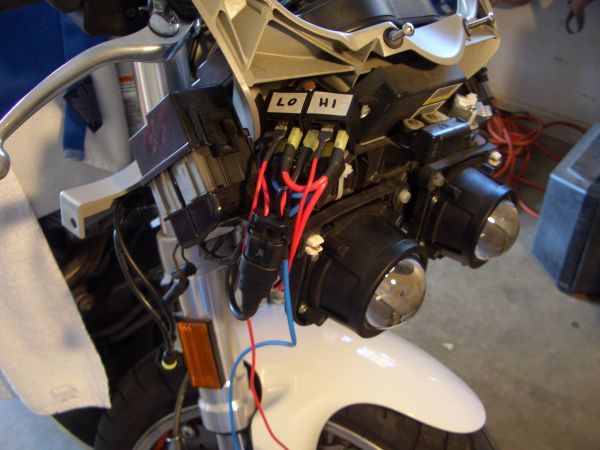 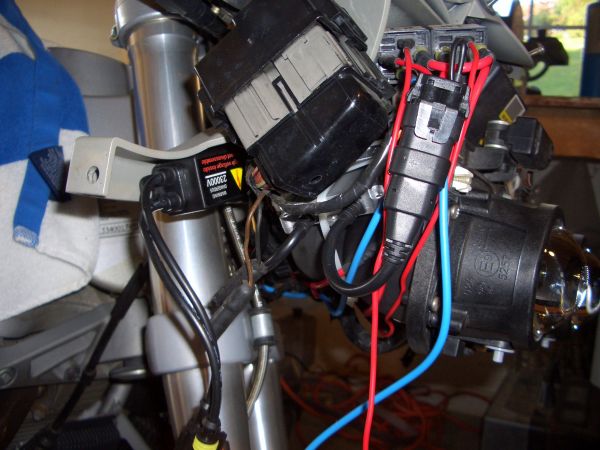 10.) Before you strap everything up, test them and make sure everything works correctly. That's really it! Obviously, I'll be editing this post with comments and such as I go through it. If anybody has anything they want explained a bit further or would like something changed, just reply and I'll be sure to include. Same goes for any additional pictures you want. Enjoy! 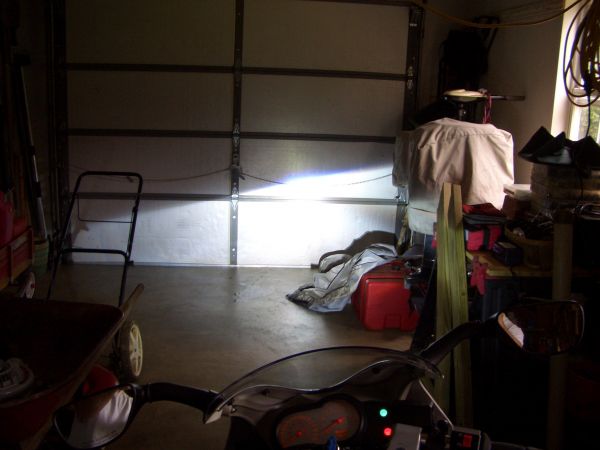 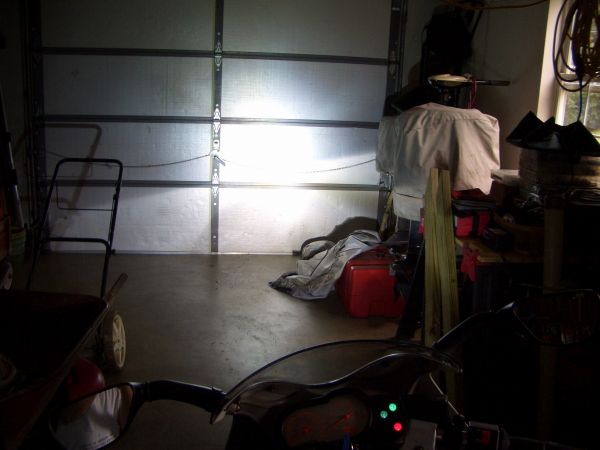 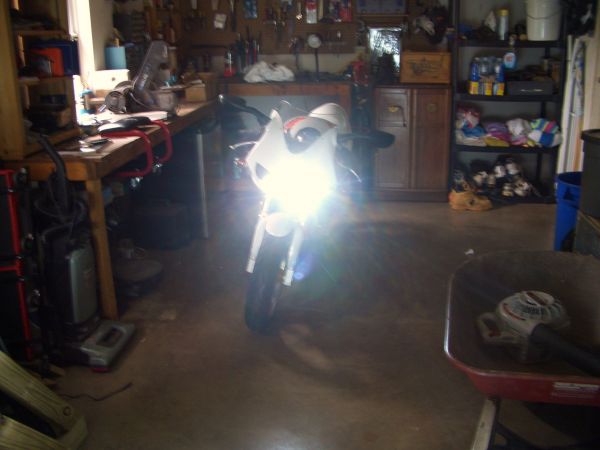 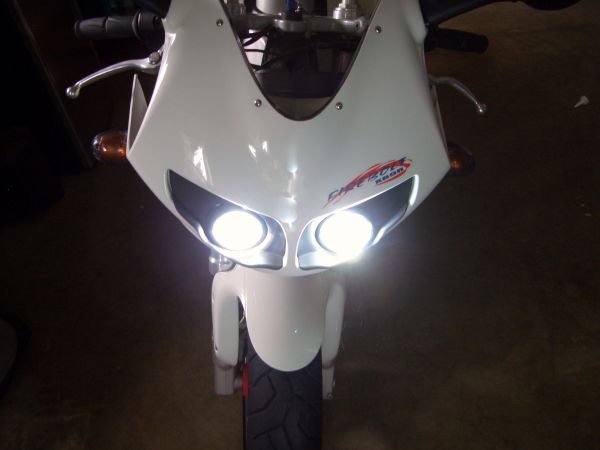 | ||
Hogs |
Excellent write up... Just a question I am about to do the same install, only thing I was going to add was, A toggle switch to pin #85 Your Blue wire going to Ground... My reason behind this is to keep Both Ballast without Power , Till the bike is warmed up and I am on my way, Just in case of stalls and having to use the Start Button to draw Amperage for start up , and so the Ballast won`t cycle off and on to much, saving the Ballast etc?? Not sure what ya thinK? Oh, Just one of thing, No need for the Ballast to be solid mounted, So it can be used for a Heat Sink , case them Ballast get hot?? | ||
Steve_mackay |
EXCELLENT writeup. Those are ALMOST as bright as the Hellas I have on my Ulybolt  I'll be following this guide to add HIDs to the wife's STT and the new CR. Thanks! | ||
Jeepinbueller |
Hogs: Many people are adding a delay module do accomplish the same purpose, but then you have to find another place to mount something else. Instead of wiring the switch in-line of the ground or power wire, which may overload it and melt it down, I would just splice it in-line with the low beam signal wire going to the relay (which was the old power wire for your OEM bulb). That way you'll know you're working within the switch's capabilities. Just make sure your high beam switch is off and you're set. Thanks Steve! I put some time into this one!  | ||
Hogs |
Jeepinbueller, Good Point, So I had heard these ballast get HOT, is that true and if so, should they be mounted to metal some how to act as a Heat sink for cooling purposes? | ||
Jeepinbueller |
Hogs: They get warm to the touch, but I've never touched one that got so hot to stir concern. I have a set in my Jeep Wrangler and they don't get any airflow at all where they're mounted ... they've never gotten really hot. The new digital slim ballasts are even better ... I've barely felt a warm one. With all the air moving around behind the cowl (vacuum) I wouldn't worry about it if you mount them behind there somewhere. You'd be hard-pressed to find a metal location on an XB flat enough to mount a pair of ballasts I reckon. | ||
B00stzx3 |
Thanks for the writeup Jeep! Gonna hack up my premade-relay harnesses to get the the relays and fuse off. | ||
L8_br8ker |
Nice write up Josh, and excellent install | ||
Jeepinbueller |
I must say that I really miss the precise lighting on the Firebolt! I have a CR now with a 55W 6000K HID bulb for both low/high beams, but without the projector lenses to control the light with precision it's a little lacking! The light output is amazing, but I can see me buying another headlamp assembly off of someone and retrofitting these in: http://www.theretrofitsource.com/product_info.php? cPath=24&products_id=237&osCsid=b2a112f04cc1543d03 8604377f051e16 I'm also going to throw those into some 7" round housings for my TJ! And for everyone who's Emailed me showing your appreciation for the write-up: YOU'RE WELCOME! I really did this b/c I have fun writing procedures (well, it's my job right now even though this particular document isn't up to par with my work-related procedures! Haha). | ||
Terrys1980 |
Jeepin I hope you don't mind I modified your diagram for the DEI 611T Relay Timer. There are a few Buellers who are going to be doing this install this winter and was looking for a diagram.  | ||
Iman501 |
thanks for this write up guys! i've got everything to do this mod, and hopefully will get it done this weekend if i can find time!!! | ||
Xb12randy |
Thanks for this How To Jeepinbuell. Did the install Saturday with a DDM tuning kit. Came out much better then expected. Since buying my 12R in 2007 I've NEVER been flashed by anyone going the opposite direction while running my high beams with the factory lights even with Silverstar bulbs. I did today  I can finally see to ride in the mornings on my way to work. Thank You Badweb community | ||
Trev_dawg2 |
Hey guys, I ordered a set of 8000K DDM HID's and plan on getting them in this week. However, I also ordered the 10 sec delay relay to help save the ballasts and lights. My question is, will the delay replace the low beam relay? I believe it does but wanted to make sure before I started assembling stuff. Here is the link for the delay: http://cgi.ebay.com/HID-Relay-Time-Delay-SPDT-10-s econd-delay-/180544858770?pt=LH_DefaultDomain_0&ha sh=item2a094fea92#ht_2446wt_905. Thanks. | ||
Terrys1980 |
No it will not replace the low beam relay. It will need to be wired in. Most prefer to use a pre-wired relay socket like this. http://cgi.ebay.com/ebaymotors/Pre-wired-Relay-Soc ket-_W0QQcmdZViewItemQQhashZitem2ea20c8d56QQitemZ2 00287227222QQptZMotorsQ5fCarQ5fTruckQ5fPartsQ5fAcc essories | ||
Trev_dawg2 |
Sorry, I think I didn't explain what I meant quite right. I am going to do the same build that Jeepinbueller explains above but was thinking I could use the delay relay in place of the regular relay for the low beam. I know it has to be wired in, I just was thinking that I only needed to buy 1 regular relay to go with the delay. | ||
Terrys1980 |
Well if thats the case yes it will replace the relay. | ||
Jeepinbueller |
Sorry I got back to your PM late Trev, glad it worked out correctly! And I'm really flattered that so many people have gotten some support by using my write-up. If anybody has any questions, shoot a PM to me and I check my Email much more often than checking in here. | ||
Mesozoic |
Just ordered a 35W@6000K H7 dual lamp kit from DDM Tuning for $45! Man, that is a good deal, for sure. My high beam (was a PIAA) went out and since they're expensive and go out once per year, I figured the HID would be a more durable option. Am I right? | ||
Mesozoic |
I finally tore into my '08 XB12Ss today. This bike is considerably different than a Firebolt in the front, mainly the lack of projector lamps and a great deal less space to mount additional parts. Being a bit skeptical of HIDs on the bike, I'm only replacing the high beam H7 at this time. I've run all the wires and am almost done with it. I'll post some pics so folks can see how I've mounted the ballast, ignitor, relay, etc. It's tight! | ||
Longshot |
Great thread! I'm switching my low beam to a single 35W DDM kit, and I have just one question that this write-up doesn't seem to answer: what do I do with the negative lead on the HID bulb? On Jeepinbueller's diagram, it's the wire going from the ballast to ground. My idea is to connect that second HID wire to the stock harness's black wire via the stock harness connector. The stock harness's yellow wire is connected to pin 86 (signal) on the relay. If I connect the second HID wire to chassis ground rather than the black wire, the the black wire isn't connected to anything at the low beam. According to the wiring diagram, the black wire just connects to the same dang chassis ground. I'm being picky and trying not to leave a previously-occupied stock harness connector empty. I guess the question boils down to, is that skinny black wire up to the task of grounding the HID ballast? | ||
Longshot |
Whoops, never mind. I think I've got it figured it out as follows: Relay pin 87 (battery) to battery positive (duh) [via new red wire] Relay pin 86 (signal) to harness yellow [via another new red wire] Relay pin 85 (ground) to harness black [via new black wire] Relay pin 30 (power) to HID positive [via built-in red wire on HID kit] Chassis ground to HID negative [via built-in black wire on HID kit] Not modifying the stock harness = happy Longshot. If the stock low beam connector wires and the wires to 86, 85, 30, and chassis ground all fit through the stock opening in the dust cover, then I'll just cut the HID kit's dust plug off and not have to cut a hole in the stock dust cover. Not modifying ANY stock parts for this installation = THRILLED Longshot. | ||
Terrys1980 |
What dust cover are you referring to? The rubber boot that goes on the light? I ended up cutting some of the rubber boot and resealing it back up with black rtv sealant. | ||
Longshot |
Terry - yes, the rubber boot that goes on the light. | ||
Longshot |
Yeesh, it's cramped behind the Ss's flyscreen! I can't seem to find a spot for the ballast that doesn't press against the horn and mute its honk, despite all the photos of people solving the same problem. Is it okay to just sort of stuff the ballast in as best I can, or does it really need to be adhered/bolted/zip-tied in place? The wire I ran from the battery is 12gauge Rat Shack special, rated up to 176 degrees Fahrenheit - is that enough? I ran the wire as best I could along the same path as the main harness and zip-tied it in two places, one in front of and below the frame (by the mouth of the left side scoop) and one above and behind the frame (near the back left airbox cover fastener). (Message edited by Longshot on February 18, 2012) | ||
Mesozoic |
Not sure what size ballasts you have, but I ordered the slim units from DDM Tuning and they fit almost perfectly behind the flyscreen of my Ss. | ||
Longshot |
Mesozoic, I have the same kit, and I only got one of them. It'll certainly fit, but I'm incredibly picky about *how* it fits. I think I got it figured out this morning, though - I can place it oriented vertically, with the flat side against the part of the wiring harness that feeds the headlight connector. Then, when I put the windscreen back on, the ballast is pinned between the wiring harness and the windscreen foam, so it won't rattle around. As a bonus, I can zip-tie the relay to the headlight bracket and the ignitor to the horn bracket, so no permanent adhesive foam is involved. I killed all of yesterday just totally overthinking the whole installation. Now that I've worked out that placement, I'm just waiting to hear from other users on the temperature rating of the wire to the battery. Once I know I've got tough enough wire, I'll get back to it. My current thought on how to install the kit without making any changes I can't undo (like cutting the rubber boot) steals a bit from the white wire mod. I can pull the black and yellow wires out of 38A, crimp on spade connectors, and plug them into the relay. I'll then cut the wires leading to the capsule, thread them through the stock boot opening (I checked and they'll just barely fit next to the stock wiring), and splice them back together. The stock low beam connector will remain inside the rubber boot, only it won't be connected to anything. It would be nice to cut the capsule wires just behind the capsule, crimp male spades onto them, and plug the capsule into the stock connector inside the boot. However, I've seen pictures of melted harnesses that indicate running the HID voltage through the stock harness is a bad idea. If I want to revert to the stock bulb, the only potential difficulty would arise from cutting the spades off the yellow and black wires and still having enough length to reinsert them into 38A. I'll post pics if this works and a warning not to attempt if it doesn't. | ||
Mesozoic |
Just keep in mind that HID current pull and power consumption after it's warmed up is considerably lower than halogens. | ||
Longshot |
Apparently I'm smart enough to install an HID low beam, but not smart enough to figure out how to make the pictures I took small enough to upload. Suffice it to say, the HID capsule wires and a pair of 22 gauge signal wires will fit through the opening in the stock boot with the stock harness still in place. It's a bit of a squeeze but it works. I simply cut the wires running from the ignitor to the capsule, threaded them through the boot, and soldered and shrink-wrapped them back together. I also cut the male spades off the HID harness. These would be useful if I were connecting the kit to the stock bulb connector, but a female spade crimped onto the red wire and a ring crimped onto the black wire allow the kit to connect directly to the relay and the chassis ground. With those four wires cut, the rubber boot that comes with the kit slides right off. Now that that's all done, I think the relay is defective. With the key off, I measured 12.4 volts across pins 30 and 87. With the key on but engine off (bike is indoors), the lights seemed to work fine. They're set up so only high (halogen) or low (HID) beam is on at a time, but I noticed that, regardless of which light was on, the battery only lasted a minute or so before the lights began to fade. | ||
Longshot |
Oh Longshot, this is what happens when you have a measly bowl of cereal for breakfast and then don't eat anything for the rest of the day. It's not a defective relay. Of course it measures 12 volts with infinite resistance! When the relay is off, the one terminal is connected directly to battery positive, and the other terminal is connected to chassis ground by way of the ballast. | ||
Mesozoic |
Cool, glad to hear it works. Do you have the 55W lamps? I'm running the 35W units and it doesn't drain the battery as bad as the halogens. Interestingly, I also added the 2nd HID to my bike this weekend. I'm running 2 relays triggered off the stock power feeds and managed to cram it all in behind the flyscreen. It looks factory! I'm struggling with the diode setup to get the simultaneous high and low on high beam, but not burn the high when switched to low beam. I added diode between the high and low relay, with the current flowing towards the low beam relay, but both lamps turn on simultaneously when switched to high and neither of them shine on low beam! If anyone has any suggestions, I'm all ears. I think I've wired it up like this guy did to his Miata: http://revlimiter.net/mods/lowpro.php, but I must've screwed something up. (Message edited by Mesozoic on February 26, 2012) | ||
Longshot |
I have the 35W kit. I never really tried to run the stocker just off battery and see how long it lasted before going dim, so for all I know, everything is hunky dory. That diode in the diagram from your link is set up to let the signal current get in to the low beam relay when the high beam is on, but not let signal current get out from the low beam wire to the high beam relay when the high beam is off. Verify that you've got the diode installed with the correct polarity and on the correct line. If you installed it backwards in the high beam line, the high beam would stay on when you switch to low beam, but the low beam would stay off on high beam. The way your lights are behaving, the diode might be installed backwards in the low beam line. If it is, and the high beam wiring is connected to both pins 86, then the lights would behave as you described. In this case, the diode is simply blocking the low beam signal current from reaching the low beam relay. As an alternative to that diagram, start by hooking the two kits up to come on independently and verify that only one light comes on at a time. Then, add a jumper between both pins 86, and put the diode in the jumper. Orient the line on the diode toward the high beam relay and the triangle toward the low beam relay. | ||
Mesozoic |
Thanks. After looking closer at my wiring job for the diode and relays, I discovered that I had installed the diode in the wrong part of the harness, so that both high and low were tied together without the diode ever coming into the picture. A bit of resoldering and heatshrink and I've got it working perfectly. Very excited about having both lamps on simultaneously now! |